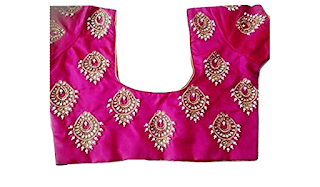A Closer Look: Understanding Aari Work vs. Maggam Work
Maggam work and Aari work are both forms of traditional Indian embroidery techniques, but they have some differences in terms of their origin, tools used, and the motifs created. Here's a comparison between Maggam work and Aari work:
Maggam Work:
1. Origin: Maggam work originated in the state of Andhra Pradesh in South India and is widely practiced in regions like Hyderabad and surrounding areas.
2. Tools: Maggam work involves the use of a specialized needle called the Maggam needle, which is curved at the end and has a hook-like structure.
3. Techniques: Maggam work combines elements of stitching, weaving, and embellishment techniques. It often incorporates techniques like zardosi (metallic threadwork), mirror work, and stone work.
4. Motifs: Maggam work typically features intricate and elaborate designs with a mix of floral patterns, peacocks, paisleys, and other traditional Indian motifs.
5. Application: Maggam work is commonly seen on bridal wear, traditional sarees, lehengas, and other festive or ceremonial outfits. It is known for its opulence and is often used to create heavily embellished pieces.
Aari Work (also known as Zardozi or Zari work):
1. Origin: Aari work has its roots in Persia and was introduced to India during the Mughal era. It is practiced in various regions of India, including Uttar Pradesh and Rajasthan.
2. Tools: Aari work involves the use of a specialized hooked needle called the Aari needle, which is attached to a wooden handle. The fabric is stretched tightly on a wooden frame to create tension.
3. Techniques: Aari work focuses on creating intricate and fine threadwork using various stitches like chain stitch, satin stitch, and beadwork. It often incorporates elements like zari (metallic threads), sequins, and beads.
4. Motifs: Aari work motifs include floral patterns, paisleys, geometric designs, and traditional Indian motifs like peacocks and elephants. The designs can range from delicate and intricate to bold and decorative.
5. Application: Aari work is used on a variety of garments, including sarees, salwar suits, dupattas, and bridal wear. It is also seen in accessories like bags, shoes, and home decor items.
While both Maggam work and Aari work are intricate forms of embroidery, they have distinct regional influences, variations in tools, techniques, and motifs. They contribute to the rich textile and embroidery heritage of India, showcasing the diverse craftsmanship and artistic traditions of different regions.


Comments
Post a Comment